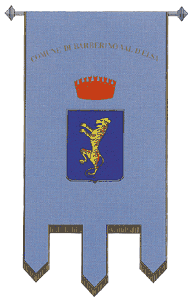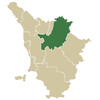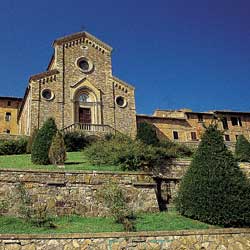|
 Inhabitants in 1991: 3.542 Inhabitants in 1991: 3.542
 The
territory of Barberino Val d'Elsa extends for 65,88 square kilometres
on the hills which separate the valleys della Pesa and dell'Elsa. It originated
as Medieval Podesta Office in the XIII century; became Seat of the
community in 1774 undergoing many changes to its borders in the course
of the centuries, until reaching its present day aspect in 1892,
when the districts of Tavernelle, Sambuca and San Donato in Poggio were
removed to constitute the new municipality of Tavernelle (becoming Tavarnelle
Val di Pesa in 1909). The
territory of Barberino Val d'Elsa extends for 65,88 square kilometres
on the hills which separate the valleys della Pesa and dell'Elsa. It originated
as Medieval Podesta Office in the XIII century; became Seat of the
community in 1774 undergoing many changes to its borders in the course
of the centuries, until reaching its present day aspect in 1892,
when the districts of Tavernelle, Sambuca and San Donato in Poggio were
removed to constitute the new municipality of Tavernelle (becoming Tavarnelle
Val di Pesa in 1909).
The first historical mention of the town name of Barberino goes back
to 1054, but the community draws its official origins from the destruction
of the nearby Semifonte (1202), when the Fiorentina republic deemed
it opportune to set up and maintain this castle in an area for the most
part dominated by powerful and rebellious feudal lineages, first
among these were the Alberti Counts. the strategic aim of this
settlement is still documented by the presence of walls (end XIII
- beginning XIV centuries) with the two gates at the extremes of the village,
which was once crossed by the Via Romana (the present day Via Cassia
which hugs it on the eastern side).
 A
small "spedale dei pellegrini" (Pilgrims Hospital) built in 1365, testifies
to the importance of the town as an ancient stop over point, half
way between Firenze and Siena. In 1313, after the castle had been
occupied by Arrigo VII, the Fiorentino government organised the
unification of the two distinct administrations of San Donato in
Poggio and Barberino allocating to the latter a residence of a
rector dependent on the Fiorentino Podesta; Barberino was than declared
capital of the Podesta Office, in the first place under the Vicariate
of Certaldo, then under that of Colle. Among its illustrious sons are
remembered Francesco di Neri Poet and Jurisconsul who died in 1348.
In the surrounds of the capital there are areas of notable historic importance
such as Marcialla (Market of the Castle of Pogna destroyed by the Fiorentini
in 1184) and the castles of Tignano, Lipari and Vico d'Elsa. A
small "spedale dei pellegrini" (Pilgrims Hospital) built in 1365, testifies
to the importance of the town as an ancient stop over point, half
way between Firenze and Siena. In 1313, after the castle had been
occupied by Arrigo VII, the Fiorentino government organised the
unification of the two distinct administrations of San Donato in
Poggio and Barberino allocating to the latter a residence of a
rector dependent on the Fiorentino Podesta; Barberino was than declared
capital of the Podesta Office, in the first place under the Vicariate
of Certaldo, then under that of Colle. Among its illustrious sons are
remembered Francesco di Neri Poet and Jurisconsul who died in 1348.
In the surrounds of the capital there are areas of notable historic importance
such as Marcialla (Market of the Castle of Pogna destroyed by the Fiorentini
in 1184) and the castles of Tignano, Lipari and Vico d'Elsa.
Places to visit:
Palazzo Pretorio, placed in
the central square it exhibits coats of arms from the XV century and
after on its facade.
Spedale dei Pelligrini, 1300s building
hosting the Community Library
S. Bartolomeo, church in
neo-Gothic style by Giuseppe Castellucci. |
Historical info reproduced upon authorization of
Regione Toscana - Dipartimento della Presidenza E Affari Legislativi e
Giuridici
Picture by Sandro Santioli
Translated by Ann Mountford
|